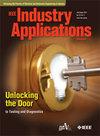General Analytical Model and Experimental Verification for Mechanical Stress of High-Speed Interior Permanent Magnet Motors Considering Modified Rotor
IF 4.2
2区 工程技术
Q2 ENGINEERING, ELECTRICAL & ELECTRONIC
引用次数: 0
Abstract
This paper proposes a general analytical model based on the equivalent centroid method to calculate the maximum mechanical stress (MMS) on the rotor of V- and flat-shape high-speed interior permanent magnet (HSIPM) motors with modified rotor. Firstly, the structure of modified rotor, which is used to reduce the core loss at high speed, is given and the analytical model for the calculation of reference stress of rotor core with or without central bridge is established correspondingly. Then, an accurate function of stress concentration factor, which can consider the effects of rotor size, number of poles and polar-arc to pole-pitch ratio, is further developed to improve the accuracy of MMS for central bridge. A static core tensile test method is proposed, which can avoid the danger caused by high-speed rotation and indirectly verify the accuracy of the proposed model and finite element analysis (FEA) results. Finally, the influence of temperature changes on the mechanical properties of core is also studied, which provides a theoretical basis for the temperature-stress field coupling analysis of HSIPM motors. Compared with FEA, the proposed model can consume less time with the acceptable accuracy, which brings convenience to initial design and optimization of HSIPM motors.求助全文
约1分钟内获得全文
求助全文
来源期刊

IEEE Transactions on Industry Applications
工程技术-工程:电子与电气
CiteScore
9.90
自引率
9.10%
发文量
747
审稿时长
3.3 months
期刊介绍:
The scope of the IEEE Transactions on Industry Applications includes all scope items of the IEEE Industry Applications Society, that is, the advancement of the theory and practice of electrical and electronic engineering in the development, design, manufacture, and application of electrical systems, apparatus, devices, and controls to the processes and equipment of industry and commerce; the promotion of safe, reliable, and economic installations; industry leadership in energy conservation and environmental, health, and safety issues; the creation of voluntary engineering standards and recommended practices; and the professional development of its membership.
 求助内容:
求助内容: 应助结果提醒方式:
应助结果提醒方式:


